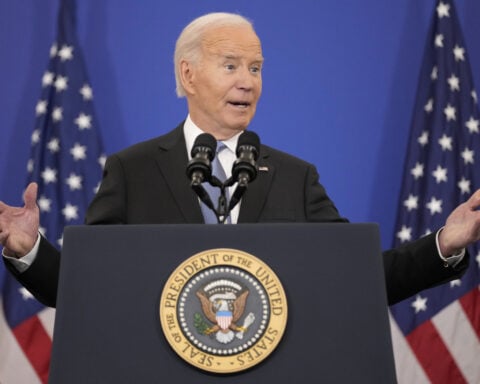SINGAPORE (Reuters) - Oil prices rose in early trade on Tuesday as escalating geopolitical tensions in the Middle East continued to fuel supply concerns.
Brent crude futures rose 25 cents, or 0.3%, to $82.65 a barrel by 0105 GMT. U.S. West Texas Intermediate crude was up 31 cents, or 0.4%, at $77.09 a barrel.
Both the contracts fell over $1 on Monday as a deepening real estate crisis fuelled Chinese demand worries, after a Hong Kong court ordered the liquidation of property giant China Evergrande Group.
But analysts say the market remains on edge amid mounting oil supply worries, as Washington vowed to take "all necessary actions" to defend its troops following a deadly drone attack in Jordan by Iran-backed militants, the first U.S. military deaths since the Israel-Gaza war began.
"If U.S.-Iran tensions escalate, particularly through a direct confrontation, the risk rises that Iran's oil supply is adversely impacted. Iranian's oil exports are likely the most vulnerable via potentially greater enforcement of sanctions," said Commonwealth Bank of Australia analyst Vivek Dhar in a note.
Iran exported 1.2-1.6 million barrels per day of crude oil through most of 2023, Dhar added, representing 1-1.5% of global oil supply.
"How Iran responds to rising U.S. tensions will also dictate the course for oil markets. The key concern is Iran threatening a blockade of the Strait of Hormuz, which sees the transit of 15-20% of global oil supply," he added.
Additionally, an attack on a Trafigura oil tanker in the Red Sea over the weekend has raised the risks around supply disruptions, while the risk of the U.S. getting dragged into the conflict is also rising, said ANZ analysts in a note.
"Traders have started covering short positions; but long positions have increased marginally, highlighting a lack of conviction for the moment," they added.
Oil's price gains also come ahead of a Federal Reserve rate decision, as the Federal Open Market Committee (FOMC) starts a two-day meeting on Tuesday.
Policymakers are expected to hold interest rates steady, but some investors believe the U.S. central bank could drop its hiking bias.
Meanwhile, U.S. crude oil and distillates inventories were expected to have fallen last week while gasoline stocks were seen rising, a Reuters poll showed.
The American Petroleum Institute industry group will publish U.S. stockpiles data on Tuesday at 4:30 pm EST (2130 GMT), while data from the Energy Information Administration, the statistical arm of the U.S. Department of Energy, is due at 10:30 a.m. EST (1530 GMT) on Wednesday.
(Reporting by Emily Chow; editing by Miral Fahmy)

 Stock market today: Asian stocks mixed ahead of US inflation data
Stock market today: Asian stocks mixed ahead of US inflation data
 TikTok seeks to reassure U.S. employees ahead of Jan. 19 ban deadline
TikTok seeks to reassure U.S. employees ahead of Jan. 19 ban deadline
 US won't seek charges in unarmed Black motorist Ronald Greene's fatal 2019 arrest
US won't seek charges in unarmed Black motorist Ronald Greene's fatal 2019 arrest
 Euro zone households could increase consumption, ECB chief economist says
Euro zone households could increase consumption, ECB chief economist says
 Foreigners sold South Korean equities last month by most since early 2020
Foreigners sold South Korean equities last month by most since early 2020
 As fires ravage Los Angeles, Tiger Woods isn't sure what will happen with Riviera tournament
As fires ravage Los Angeles, Tiger Woods isn't sure what will happen with Riviera tournament
 Antetokounmpo gets 50th career triple-double as Bucks win 130-115 to end Kings' 7-game win streak
Antetokounmpo gets 50th career triple-double as Bucks win 130-115 to end Kings' 7-game win streak
 No 97 Laura Siegemund upsets Olympic champion Zheng Qinwen at the Australian Open
No 97 Laura Siegemund upsets Olympic champion Zheng Qinwen at the Australian Open








